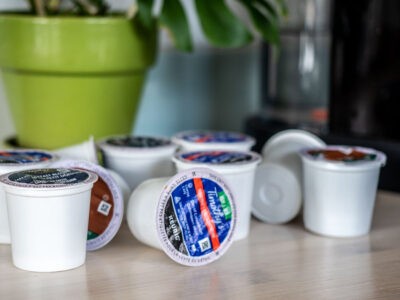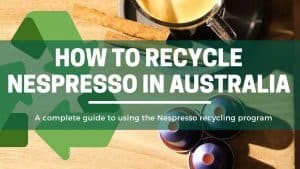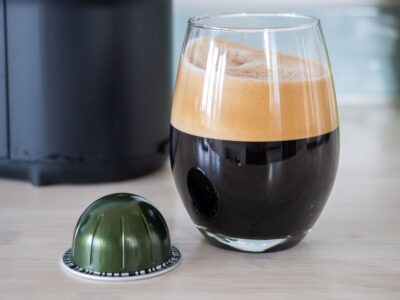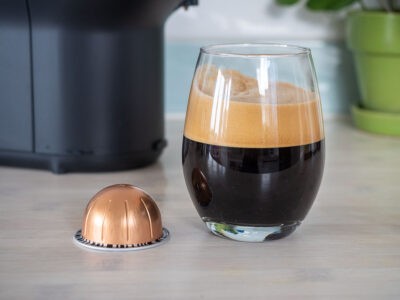Nespresso Guides, Recycling Guides
How Single-Use Coffee Capsules Are Destroying Our Planet
Capsule coffee machines may seem innocent enough – in fact, they’ve become an essential appliance in the modern kitchen. They are quick, clean, convenient and bring the experience of cafe style coffee to your home.
What we’re not told is that these innocuous little pods could be contributing to a global environmental disaster, with around 56 billion ending up in landfill last year alone. Every minute a whopping 39,000 capsules are made worldwide, while 29,000 are dumped in landfill sites.
As these truths come to light, some of the world’s biggest producers of coffee pods have been forced to rethink their strategies and appeal to a more environmentally conscious consumer base. For instance, Nespresso has successfully deployed its recycling program in 44 countries.
But are coffee pods really this big of a risk to the environment? Has the recycling programs fixed the problem? Or is this all for show?
We’ve taken a look at what the real impact of single use coffee pods is, and what you can do to play your part in minimising it.
Key facts about the damage coffee pods are doing to the planet:
- Coffee pods take between 150 and 500 years to breakdown in landfill
- 44% of Nespresso pods are taken to be recycled
- 56 billion pods ended up in landfill last year alone.
Why Listen To Us? Well, because we KNOW coffee! In fact, we make our own coffee, coffee machine cleaners, and reusable capsules which we've sold to over 41 countries. Our team ouf experts include Tristan (an engineer), Claire (a food writer) and Richy (a barista). So, whether you're looking for a recipe or repair guide, we've got you covered 💚
Table of Contents
“No kitchen is complete without one” – The rise in popularity of Capsule coffee.
Nespresso doesn’t disclose revenues or profits. The brand now has over 10,000 employees and operates in 67 countries. As of 2012, which was the last year the brand reported on their sales volume, Nespresso sold around 27 billion pods! We estimate this number combined with other coffee pod brands is now closer to 56 billion.
Nespresso started in 1976, when Eric Favre, a Nestlé employee, invented, patented and introduced the Nespresso system to the business market in Switzerland. Nespresso debuted its flagship in Japan, and rolled it out to consumers in Switzerland, France, Italy and Japan in 1986. Originally an e-commerce business, Nespresso opened their first physical boutique in Paris in 2000 as a concept store.
Today, Nespresso has a global network of more than 700 boutiques in 67 countries.
Research suggests that the popularity of coffee capsules is growing at its fastest ever pace. In fact, approximately one in every three UK homes now has at least one coffee pod machine in operation. In the United states, this figure is over 40%.
Nespresso’s patents began to expire in 2012, gradually allowing competitors to offer capsules and machines compatible with the Nespresso system. Many brands have since then come up with their own Nespresso-compatible pods. If you go to a supermarket today, you’ll be offered a plethora of alternatives.
How many coffee pods are sold each year?
Nespresso’s last official data was released in 2012, so it’s difficult to tell exactly how many pods they’re selling now. By 2012 it had sold 27 billion single-use capsules worldwide.
But let’s compare with another coffee pods manufacturer, Keurig Green Mountain, who are the manufacturer of Keurig Capsules and hold the lion’s share of the single use coffee pod market in the United States. They sold around 13.2 billion capsules in 2018 (Source).
Since its inception, the single-serve capsule business has flourished – making up 34% of all coffee sales globally. Today, 41% of Americans own a single-serve brewing system. And even though adoption is starting to slow down as the market saturates, this business is still projected to grow by 5% each year.
John Sylvan, the creator of the original K-cup coffee system by Keurig has since admitted, when he looked back at what he had created “I feel bad sometimes that I ever did it”.

What are Nespresso pods made from?
Nespresso pods are made a specific aluminium alloy knows as 8081. They are then coated with a thin film of plastic and an epoxy varnish to stop the metal from oxidising.
The recycling processes
It’s no easy feat to break down the coffee pods into the original components and recycle.
First, each capsule needs to be shredded and put through a washing machine. This is used to separate the coffee grounds from the plastic and aluminium capsules. The shredded material is dried and heated to a point where the plastic varnish melts away. Finally, the aluminium scraps are passed into a furnace and melted down and reconstituted into aluminium ingots.
It’s a lengthy process and requires plenty of water and energy. Even recycling has an environmental cost.
Recycling Nespresso pods
We’re actually quite impressed by the lengths Nespresso has gone to implement its recycling program on a global scale. In most countries, Nespresso offers dedicated recycling bags, which you can return full of your used pods to drop-off points at Nespresso stores, post shops, supermarkets, and even florists.
To date, Nespresso has become one of few brands to demonstrate its commitment to environmental concerns. While most major manufacturers continue to produce disposable plastic coffee capsules, the latest Nespresso capsules are made from 100% recyclable metal. Of course, it remains to be seen whether the market’s other leading coffee pod brands will take the same route, but it’s great to see at least one brand making a real effort to change for the better.
We’ve written a compressive guide on how you can recycle your Nespresso capsules in New Zealand. Read it here.
We’ve also come up with some great creative ideas for reusing the spent coffee grounds around the home. Check them out and tell us which of these you’d like to implement at your own home.
Accessing Nespresso’s recycling locations worldwide
Nespresso has put in place a recycling programme for its aluminium Nespresso and Vertuoline capsules in 44 countries. Indeed, aluminium is an infinitely recyclable materials, so why not recycle it?
Out of the 44 countries enrolled in the program, consumers can dispose of the capsules in their recycling bins in 6 of them. In 15 countries they can ship them off back to Nespresso through the postal system for free. For the 23 other countries, there are 122,287 collection points worldwide where you can drop off the used capsules.
There is no need to empty or wash out the capsules, you just throw them as is. In theory, not a bad scheme. Unless you live in one of the countries where you need to drop off the capsule at a collection point and they’re not very close to your home.
Australia
Originally the only way one could recycle a Nespresso coffee pod was to take it to a Nespresso boutique. Now, Nespresso has partnered with Terracycle and Toll couriers to improve the accessibility of the program. You can drop off coffee pods at selected participating florists all around Australia. There are more than 340 drop-off points across Australia. From there Toll couriers pick up the discarded pods and transport them to a Nespresso recycling facility where the aluminium is made into more coffee pods or other aluminium products. For those who don’t live near a collection point, there’s the option to buy specific plastic collection bags at the post office and mail the pods off to Nespresso boutiques.

USA
Nespresso no longer partnered with Terracycle in the USA and the only place customers can physically drop off your pods is at one of only 45 Nespresso boutiques across the country. Alternatively, customers can order a prepaid UPS postage bag when ordering their pods, which holds about 200 traditional capsules.

Canada
In Canada, there are 19 collection points. As well as Nespresso boutiques, the pods can also be taken to selected Home Outfitters stores.
New Zealand
In New Zealand, Nespresso provides the following three options to recycle used coffee pods.
- Fill a pre-paid post bag and drop off at your nearest NZ Post Shop.
- Return to the recycling bin in any Nespresso Boutique store.
- Recycle at a participating florist or garden center collection point.
Read our full guide here as we discuss how this all works.

The impact of single use coffee pods on the environment.
While praise is due for all the good intentions that are behind the Nespresso recycling program, we now have to consider what happens to the (majority of) pods that don’t end up in a recycling facility.
The impact those pods have made on the environment is undoubtedly horrific. Over the years, the demand for the Keurig coffee makers have only increased (more than 38 per cent of all Canadian households own one, whether it be Keurig, Hamilton Beach, Cuisinart or another) and has grown to become a billion-dollar company — with no signs of slowing down. Unfortunately the massive growth also equals massive garbage because, for the most part, the pods aren’t recyclable and the huge amounts of plastic waste wind up in landfills.
“It’s like a cigarette for coffee, a single-serve delivery mechanism for an addictive substance,” said John Sylvan more than 30 years ago, explaining the appeal of single-use coffee capsules.
Convenience, ease and consistency are the reasons for coffee capsules are an enormous success. You pop your capsule into the machine, a few seconds later you enjoy your coffee. You throw it away without thinking twice about it.
But in the past decade people have become more conscious about the environmental impact of their habits and the coffee capsule industry has come under scrutiny. In 2014, a video titled “Kill the K Cup” came out and caused an uproar against Keurig. A parody of Hollywood alien invasion movies, it criticised the volume of unrecyclable capsules produced by the American company the previous year, which it claimed, could encircle the Earth 10.5 times.
Is Nespresso’s recycling program effective?
Nespresso is quick to point out that they can recycle 86% of their coffee pods worldwide, but this doesn’t quite tell the full story. There’s clearly a difference between ‘can’ and ‘is’… So, what are the actual recycling numbers?
In 2017, Nespresso “valorised” 56% of their used capsules – meaning that 44% of their capsules end up in landfill (source). Of the collected capsules, some are used in energy production, leaving only 24.6% to be actually recycled.
Aluminium is a great material because it is potentially infinitely recyclable. But Nespresso doesn’t use recycled aluminium for its capsules. The brand claims its capsules require a “specific alloy of aluminium” – alloy 8011 that is not found in recycled aluminium and one of the only sources are recycled Nespresso capsules. In fact, all of most of the recovered aluminium is used in other various projects.
Since Nespresso started testing the feasibility of a capsule-to-capsule approach in 2015, it’s produced 10 million capsules or 0.1% of production demand for that same year!
Thus, most of their aluminium comes from virgin material. And while recycled aluminium is quite easy to recycle, ore extraction is highly energy-intensive, consuming incredible amounts of water, electricity and resources.
In the US, half of the electricity consumed in the smelting process comes from coal, one of the most polluting fuel sources we have available. Extraction of raw aluminium ore (known as bauxite) also means destroying ecosystems and natural habitats of many animals. High amounts of greenhouse gasses are also released during smelting and processing.
And while Nespresso has pledged sustainable aluminium sourcing, the use of virgin aluminium still uses 95% more energy than recycling it.
So, on the one hand, despite the company’s efforts, almost half of the capsules sold keep ending up in landfill either due to gaps in the collection system or in the unwillingness of consumers to get on board. On the other hand, the single-use approach is still making use of invaluable energy and resources that could be avoided.
So, it’s clear from this that recycling isn’t the silver bullet they claim it to be. So what are the other options? Are there compostable capsules or refillable pods that we can choose to use instead?
Compostable and biodegradable capsules
There’s been a surge in manufacturers who celebrate a point of difference by now offering bio-degradable or compossible coffee pods compatible with the Nespresso range of machines. This is definitely a step in the right direction, but it’s important to understand what is really meant by these ecological buzz words and to understand if this is really making a difference.
Biodegradable refers to a material that will disintegrate over time in the ocean or ground with the help of bacteria and enzymes. This can happen in a short time or it can take many years.
The term compossible takes this one step further by referring to a material that, when it breaks down, adds to the nutrient content of the soil thus forming compost. Compostable products need to breakdown at a similar rate to the materials it’s composted with such as food scraps or green matter – although there’s no official timeframe given for this to happen.
So what does this mean? Compossible coffee pods give us the best peace of mind when looking for a sustainable solution. Biodegradable coffee pods may seem like they took the same box but could take years to disintegrate fully and still leave toxic or non-organic compounds behind.

What about refillable coffee capsules?
In the mantra “reduce, reuse, recycle” before recycling comes reusing. Rather than buying a single-use product in the first place, we can change our buying habits and look for a reusable alternative.
Slowly but surely, more and more households are making the switch to reusable coffee capsules. You fill the capsule with your favourite ground coffee, use it in your machine, empty it, rinse it and use it again. It’s the easiest and most accessible way for most people to make delicious espresso coffee at home without having to cough up for a cafe-quality machine.
This is where we come in! Already we’ve saved over 500,000 single use pods going to landfill… and we’re just getting started!! You can learn more about our green pods by following this link.

Ditch single-use
Every minute about 39,000 capsules are made worldwide, while 29,000 are dumped in landfill sites. Whether we’re buying single-use pods such as Nespresso or green alternatives such as biodegradable or compossible capsules, we are still dependent on a new product being produced for every single cup of coffee we drink. Materials need to be extracted, processed, produced, shipped, collected and recycled consuming enormous amounts of energy and resources. This creates pollution and as such leaves behind a large and unnecessary carbon footprint.
The only truly sustainable solution is to switch from single-use products to reusable ones. They may take a little time and effort to fill and clean, but it’s the only sure way to truly minimise our carbon footprints. Besides, this may not be any more of a hassle than emptying single-use capsules for effective recycling and then shipping them back or taking them to collection points.
And while of course the price of a refillable capsule is higher than that of single-use capsules when you buy them, they work out far more cost-effective in the long term when you compare the price of loose coffee with the price of coffee in pre-packaged pods. Our pods pay themselves off in less than three months!
Greenpeace’s stance is that the solution needs to be “a shift away from throwaway dependent modes towards a new business model that priorities the reduction of raw material needs, through alternative product designs and long-living and reusable products”. Makes a lot of sense.
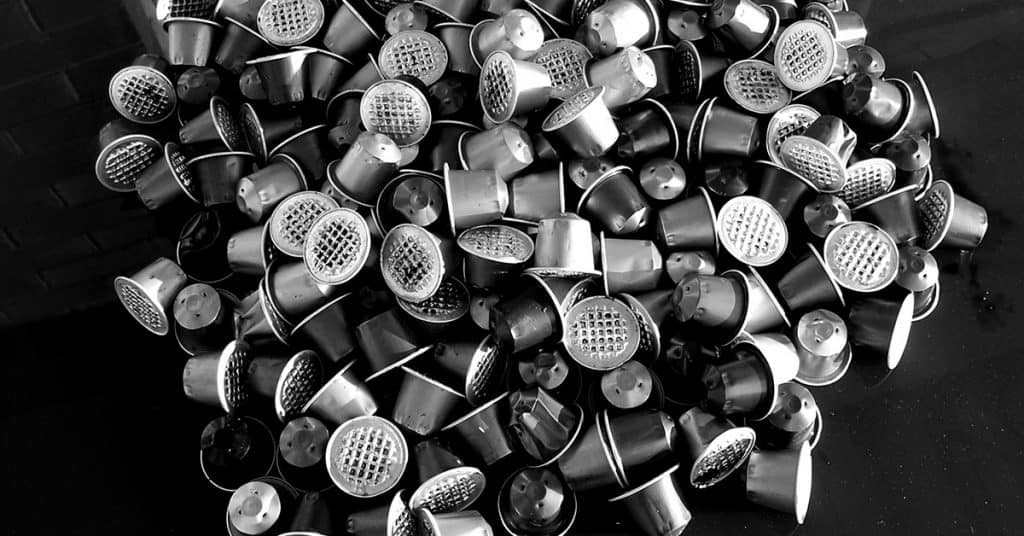
Conclusion
It turns our capsule coffee machines aren’t just a fad – they’re here to stay. In fact, they’re a mult-billion-dollar market that continues to grow 5% annually.
But, more and more manufacturers recognise the damage that single-use capsules are doing to the environment (or at least to their brand image) and are making big changes to support the recycling of their products.
While this looks good for the retailer it’s only one side of the equation. With consumers slow on the uptake or reluctant to go the extra mile to recycle, it doesn’t look like recycling is a viable solution to this problem long term.
Even the capsules that are recycled require a massive energy input to the process in order to separate the coffee grounds, plastic and aluminium into their individual components.
This is undoubtedly a step in the right direction, but more needs to be done.
The only viable solution is to switch from a mindset of recycling, to one of choosing reusable products in the first place.



